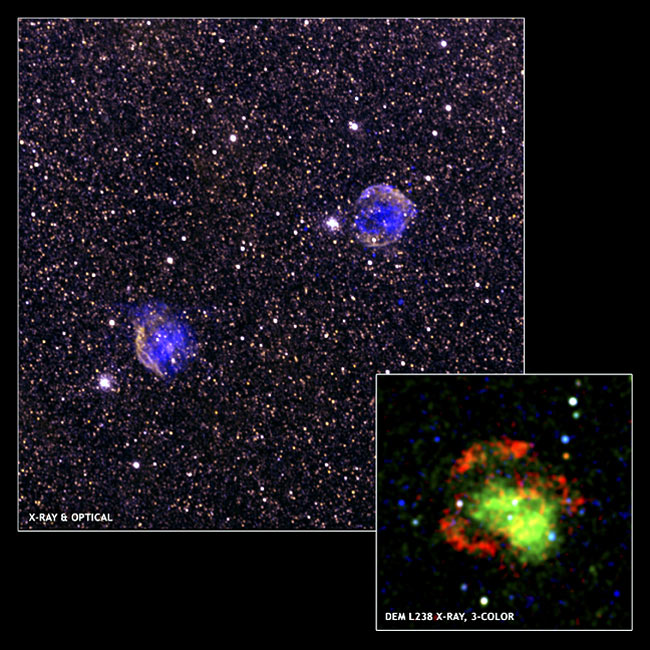
An unusually thick veil of gas discovered around the remains of two stellar corpses suggests some stars might have short fuses that allow them to explode much sooner than their peers.
Such "prompt" supernovas could provide scientists with a new way of studying events in the early history of the cosmos.
Small- and medium-sized stars, our Sun included, will shrivel into dense stellar corpses known as white dwarves when their fuel runs out. A lone white dwarf will gradually cool over time until it fades into darkness. But a white dwarf that has a nearby companion star will siphon gas from its neighbor. Over the course of billions of years, the paired white dwarf sucks off enough matter that it reaches a critical mass, at which point it undergoes a massive stellar explosion known as a Type 1a supernova.
Using NASA's Chandra X-ray Observatory and the European Space Agency's XMM-Newton, researchers spotted high concentrations of iron in the vicinity of two supernova remnants, DEM L238 and DEM L249 [image], located in the Large Magellanic Cloud, a nearby dwarf galaxy. This is typical of white dwarf explosions.
The researchers noticed something else, though: The remnants' surrounding gas was hotter and shined brighter in the X-ray than typical Type 1a supernovas.
"We weren't around to see these stars before they exploded, but these X-ray clues tell us that something unusual happened in the case of these two," said study team member Sean Hendrick of Millersville University in Pennsylvania.
The researchers say the most likely explanation for the anomalous finding is that the stars which evolved into the white dwarfs were more massive than usual. The more massive a star is, the more gas it expels into its environment before it dies.
Get the Space.com Newsletter
Breaking space news, the latest updates on rocket launches, skywatching events and more!
"We know that the more massive a star is, the shorter its lifetime," said study team member Kazimierz Borkowski of North Carolina State University, Raleigh. "If such a star could also begin to pull matter from its companion at an early stage, then this star would have a much shorter fuse and explode in only about 100 million years-much less than other Type 1a supernovas."
Prompt Type 1a supernovas could provide scientists with a new tool for probing the early universe. Scientists have traditionally used Type 1a explosions as cosmic mile markers, or "standard candles," to study the accelerated expansion of the universe because they are thought to shine with nearly equal brightness wherever they occur in the universe (this assertion has recently come under question, however).
If there is a class of stars that die and then explode more quickly than others, and if these stars were present during the early days of the universe, then they would have perished much earlier than other stars.
If scientists could detect the light from these early star deaths, they would have a powerful new tool for studying expansion in the universe's early epochs.
- Top 10 Star Mysteries
- Vote Now: The Strangest Things in Space
- New Life in Dead Star: Supernova 'Changing Right Before Our Eyes'
- Strange Supernova Defies Theory
Join our Space Forums to keep talking space on the latest missions, night sky and more! And if you have a news tip, correction or comment, let us know at: community@space.com.
Ker Than is a science writer and children's book author who joined Space.com as a Staff Writer from 2005 to 2007. Ker covered astronomy and human spaceflight while at Space.com, including space shuttle launches, and has authored three science books for kids about earthquakes, stars and black holes. Ker's work has also appeared in National Geographic, Nature News, New Scientist and Sky & Telescope, among others. He earned a bachelor's degree in biology from UC Irvine and a master's degree in science journalism from New York University. Ker is currently the Director of Science Communications at Stanford University.









